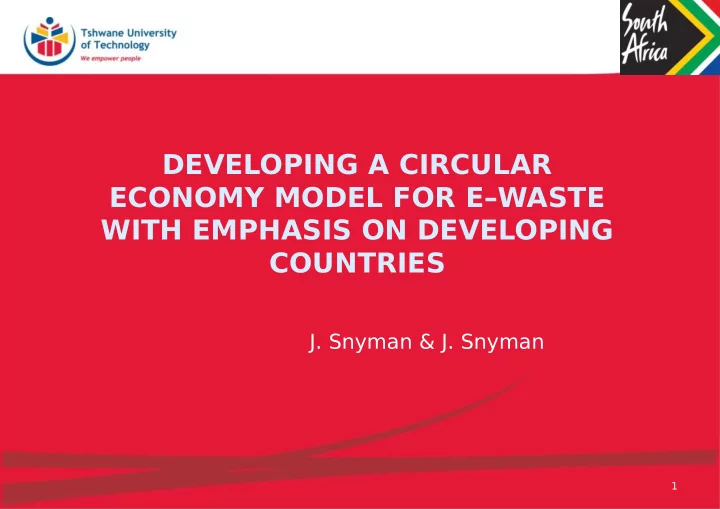

DEVELOPING A CIRCULAR ECONOMY MODEL FOR E–WASTE WITH EMPHASIS ON DEVELOPING COUNTRIES J. Snyman & J. Snyman 1
O ut l i ne Introduction Aim of the study Legislation and programmes Closed loop economy model principles E-waste management in developing countries Activities for the circular e-waste model Conceptual circular E-waste model Conclusion and recommendations 2
O UTLI NE 3
I nt r oduct i on E-waste = Electrical and electronic equipment at end of life E-waste = One of the fastest growing waste stream in the world 4 th IR – IOT – AI and M2M communication and learning = increase e-waste Old equipment sent to poorer, developing countries Legislation are not enforced and reluctant governance poses a threat Change from linear model to circular thinking = manage and reduce e-waste 4 th IR introduces smart ways to rethink and reconsider product life cycles 4
Ai m of t he st udy T o review e-waste: Legislation Programs Closed loop economy models E-waste in developing countries Develop a conceptual circular model for e-waste Elaborate elements within the circular model Recommend the way forward in implementing and testing the model 5
Ai m of t he st udy 6
Legi sl at i on and pr ogr am m es Diffjculties in developing countries with : Adoption T ypical e-waste management Enforcement model of a developed country Accountability Governance Lacking resource allocation and infrastructure for e-waste management Results in trans-boundary movement of e-waste from developed to developing countries Waste issue shifted to poorer countrie s 7
Legi sl at i on and pr ogr am m es T ypical e-waste management model of a developed country • system consists of a circular management model • fmow of material versus the movement of funds is managed & directed to relevant stakeholders. Note - an authority manages the recycling fees, which is only obtained from the manufacturer and 8 importer.
Legi sl at i on and pr ogr am m es Extended Producer Responsibility (EPR) Producer responsibility for full life cycle Designing for end-of-life and allows for a circular economy approach EPR promotes re-use, remanufacture and recycle Product Responsibility Organisation (PRO) Assist and manage activities of EPR PRO’s regulate and manage to assist governments Useful to assist large corporations Large corporations have adopted EPR’s 9
Cl osed l oop econom y m odel pr i nci pl es 2 nd industrial revolution Notice how circular activities impact the linear model The shift can be done in phases Linear activities must fjrst be dealt with individually Once isolated linear activities have become circular, the model can be fully expanded Move from a complete linear to a complete circular 10 model
Cl osed l oop econom y m odel pr i nci pl es BS 8001 circular economy Performance economy model standards (practical framework for (PE) implementing principles of circular economy in (model changes the role of resources and the manner in which organizations) resources are applied) Cradle to Cradle versus the Cradle to Grave principle 11 (business strategy that mimics the circular cycle of nature, in which waste is re-used)
Cl osed l oop econom y m odel pr i nci pl es Reversed Logistics (opposite of conventional forward logistics. It is the means of a manufacturer to accept previously sold products to possibly recycle or remanufacture ) Linear economy versus Circular economy 12
E- was t e m anagem ent i n devel opi ng count r i es Unsafe practices and uncontrolled Poor regulations and uncontrolled quantities T oo much waste to efgectively manage Facilities required to improve safety and effjciency 13
Act i vi t i es f or t he ci r cul ar e- w ast e m odel Key activities and stakeholders Group A regulates and enforces Group B manages and assists day to day activities Group C are the e-waste circular activities 14
Conc ept ual c i r c ul ar E- was t e m odel Important to defjne a boundary Boundary must contain activities and process which needs regulation Infmows, outfmows must be defjned Hazardous materials require special attention Flows between activities must be managed and information studied The more resources introduced, the more data to improve systems 15
Conc ept ual c i r c ul ar E- was t e m odel Notice the boundary layers Outer level (orange) Circular model (red) Primary & secondary model Secondary useful for re-use and re- furbished products Secondary fmow is preferred in developing countries Primary fmow is preferred in 16 developed
Conc ept ual c i r c ul ar E- was t e m odel Minimise outfmow of circular modal-seen as waste! Reduced infmow of raw materials into circular boundary 17
Conc l us i on and r ec om m endat i ons Require data and better management in developing countries Stricter policy to stop excessive, unregulated trans-boundary movement of e-waste Introduce resources allocation towards data collection and monitoring in developing countries Adapt models based on data from developing countries Implement and test circular modals in e-waste, starting with singular products as a starting point 18
TH A N K YO U J. Snyman & J. Snyman 19
Recommend
More recommend